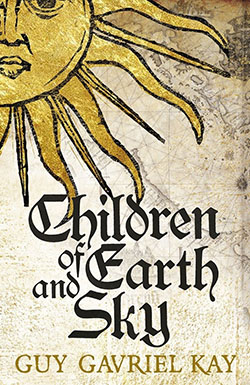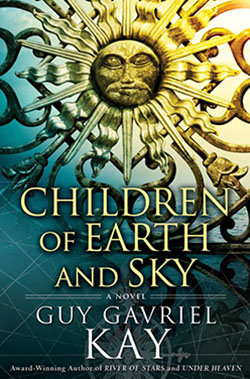Children of Earth and Sky sees contemporary fiction’s finest fantasist return to the site of the Sarantine Mosaic and the subjects of The Lions of Al-Rassan in a magnificently modest affair more interested in the myriad men and women caught in the crossfire of the holy war that flickers around its fringes than it is that momentous event.
The most apparent casualty of the the conflict so far is the city of cities itself, for just as Constantinople was toppled by the Ottomans, Sarantium in all its unimaginable majesty has finally fallen to the followers of an indomitable conqueror. It’s known, now, as Asharias, “and the man who ruled there amid gardens where silence was apparently the law on pain of strangulation […] wanted to rule the world.” You might imagine his megalomaniacal designs would inspire the several cities in the vicinity to put aside their trivial differences—after all, if Sarantium can be successfully sieged, then nowhere is safe from the Osmanli Empire’s plans to expand.
You’d be mistaken, I’m afraid. Sadly for the people of Seressa and Dubrava, the governing bodies of Kay’s vibrant versions of Venice and Dubrovnik are entirely too dependent on trade to even consider open conflict:
For the Seressinis, the idea of peace, with open, unthreatened commerce, was the most important thing in the god’s created world. It mattered more (though this would never actually be said) than diligent attention to the doctrines of Jad as voiced by the sun god’s clerics. Seressa traded, extensively, with the unbelieving Osmanlis in the east—and did so whatever High Patriarchs might say or demand.
Despite the annual march of the Grand Khalif’s army on the nearby Woberg fortress, Seressa’s Council of Twelve are markedly more active regarding their rivalry with Dubrava, which nation-state they see as “a pale, circumscribed, permitted shadow” next to the “light like the sun of Jad” their own republic represents:
Accidents had happened to Seressinis in Dubrava in the past. The smaller republic was diplomatic, cautious, crafty. It watched the winds of the world. It was also proud of its freedoms. The people of Sauradia and Trakesia, all those over that way, had a history of violence and independence going back to when many of them were pagans in the days of the Sarantine Empire, when Sarantium ruled the world.
But Seressa does not war with duplicitous Dubrava either. Instead, it spies. And spies. And spies, amusingly, on the spies spying on its own spies. As one such one spy sighs when confronted by another: “There was always someone spying. There wasn’t much you could do about it. Information was the iron key to unlock the world.” And granted: important information is important. But only if you’re prepared to translate it into action, and alas, neither Seressa nor Dubrava are.
 The pirates of Senjan, on the other hand—a community of holy warriors inspired, according to the Acknowledgements, by the Uskoks of ancient Croatia, and cast here as a thorn in the side of Seressa, whose ships they pillage because of their affiliation with the infidel—the Senjani aren’t given to deliberating. They do, to bring glory to their god, and they die. They’ll have the opportunity to do both before Children of Earth and Sky is over…
The pirates of Senjan, on the other hand—a community of holy warriors inspired, according to the Acknowledgements, by the Uskoks of ancient Croatia, and cast here as a thorn in the side of Seressa, whose ships they pillage because of their affiliation with the infidel—the Senjani aren’t given to deliberating. They do, to bring glory to their god, and they die. They’ll have the opportunity to do both before Children of Earth and Sky is over…
This, then, is the grand sweep of Kay’s latest: a contested coast populated by powers little and large on the cusp of a conflict that could change the world as dramatically, perhaps, as the sacking of Sarantium. And it’s engrossing, of course. The stakes are great, the scenario resonantly rendered, and we care about the players—which is to say the many, many people we meet, however briefly, but also the settings themselves. In Senjan, Asharias, Seressa and Dubrava, Kay gives us underdogs to dig in with, bullies to boo, blustering bystanders to bemoan and scrappy upstarts to support. Dynamics are developed between the text’s central perspectives, certainly, but above and beyond these, the places they hail from have a whole engrossing story of their own.
The unfolding of that story is sure to be surmised as slow by some, but Kay has never been the sort of author to race towards a destination. The joy of his novels is invariably in the journeys—in the unexpected turns they take and the caravan of characters they gather—and Children of Earth and Sky is no exception in that respect. “Nothing about this […] requires or is assisted by speed,” as a passing chancellor suggests, supping at a cup of fine warmed wine; a telling testimonial Kay revisits at a later stage:
It is a mistake to think that drama is steady, continuous, even in tumultuous times. Most often there are lulls and lacunae in the life of a person or state. There is apparent stability, order, an illusion of calm—and then circumstances can change at speed.
And what an impact it has when they do! When the calm is shattered by sudden stormfronts; when the journey is interrupted by bandits or betrayal or some twist of history that’s happened in the background; when the large is inflicted on the unwitting little—this, I think, is what Children of Earth and Sky is most interested in. Not the Earth-changing events themselves—though they happen, and Kay’s cast is caught up in them—but the effects these events have on a handful of human beings pulled principally from “the twinned worlds of commerce and courts.”
They are Marin Djivo, Leonora Valeri, Pero Villani, Danica Gradek and Damaz. They are the second son of a successful merchant, the disgraced daughter of a well-to-do family which cast her off like old clothing, an aspiring artist asked to paint an important portrait, a young woman who wants nothing more than to hurt those who hurt her, and her abducted brother.
They are not queens or commanders or even advisers, these people, but that does not mean they are unremarkable. They are not causal in the changing of the world, but the changing of the world causes their worlds to change—and their worlds are not without worth; they have magic and meaning, heartache and horror, hope and beauty and truth, too. As the Seressini ambassador has it: “Not everyone could be a master. You could shape an honourable life somewhere below that level of accomplishment. It felt like an important thought.”
And it is, in the hands of contemporary fiction’s finest fantasist. A book of the year to be about ordinary people not so different from you and me, Children of Earth and Sky is every inch the equal of the superlative Sarantine Mosiac, “even if no one worked with stone and glass anymore.”
Children of Earth and Sky is available now in the US (Penguin) and May 12th in the UK (Hodder & Stoughton).
Niall Alexander is an extra-curricular English teacher who reads and writes about all things weird and wonderful for The Speculative Scotsman, Strange Horizons, and Tor.com. He lives with about a bazillion books, his better half and a certain sleekit wee beastie in the central belt of bonnie Scotland.










